 Crow Dog's Case
Crow Dog's Case Published online by Cambridge University Press: 23 September 2009
No one knows what moved Crow Dog to shoot Spotted Tail on the Dakota prairie. The Brule Sioux even today are divided in their opinions. Spotted Tail is seen by many in the tribe as a heroic figure, a man who kept the tribe together in difficult times in the 1870s, protecting his people's interests. Crow Dog's people still live on the Rosebud Reservation; they are respected traditional leaders still opposed to tribal policies seen as too accommodative of U.S. interests. Crow Dog was among the leaders of the Ghost Dance movement, leading his people north from the Rosebud to the Badlands to await their rebirth. Spotted Tail's people still run the Rosebud Reservation, and Sinte Gleska College, the reservation's community college named after Spotted Tail, is one of the Brule's most vital institutions. A full understanding of the differences between the two men requires an understanding of Brule culture that white Americans simply do not have. Crow Dog's case involves two completely distinct cultural contexts, one the legal culture of the Indian tribes, the other nineteenth-century U.S. legal culture.
Toward an ethnolegal history of Indian law
Only Brule law could penetrate this unknowable world, come to an understanding of Crow Dog's case, and settle it in a way that preserved the integrity of the Brule people. Crow Dog's motives for killing Spotted Tail were intricately bound up in his humanity and cultural identity.
To save this book to your Kindle, first ensure [email protected] is added to your Approved Personal Document E-mail List under your Personal Document Settings on the Manage Your Content and Devices page of your Amazon account. Then enter the ‘name’ part of your Kindle email address below. Find out more about saving to your Kindle.
Note you can select to save to either the @free.kindle.com or @kindle.com variations. ‘@free.kindle.com’ emails are free but can only be saved to your device when it is connected to wi-fi. ‘@kindle.com’ emails can be delivered even when you are not connected to wi-fi, but note that service fees apply.
Find out more about the Kindle Personal Document Service.
To save content items to your account, please confirm that you agree to abide by our usage policies. If this is the first time you use this feature, you will be asked to authorise Cambridge Core to connect with your account. Find out more about saving content to Dropbox.
To save content items to your account, please confirm that you agree to abide by our usage policies. If this is the first time you use this feature, you will be asked to authorise Cambridge Core to connect with your account. Find out more about saving content to Google Drive.